Tuesday, 1 September 2015: Fish, tiles, art, confectionary, tripe, and feijoada
Written 12 June 2016
As you can see from the title of this page, we had a busy day. Further research into the Tuesday craft fair in Viseu revealed that it's not on Tuesdays after all, that it's not every week anyway, and that no one knew when the next one would be.
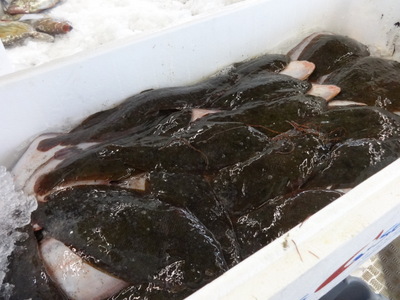
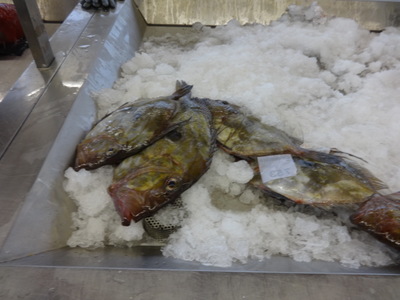 The guys went off to the meetings are usual after breakfast, and Jeannie, Kathy, and I addressed ourselves to the next item on our list—the fish market! We passed through the regular vegetable and meat market on the way, but it had nowhere near the interest of the fish. The market itself is a purpose-built, modern square building with large doors on all four sides, built-in bins for fish and ice, floor drains and hoses, etc.
The guys went off to the meetings are usual after breakfast, and Jeannie, Kathy, and I addressed ourselves to the next item on our list—the fish market! We passed through the regular vegetable and meat market on the way, but it had nowhere near the interest of the fish. The market itself is a purpose-built, modern square building with large doors on all four sides, built-in bins for fish and ice, floor drains and hoses, etc.
At the left here is a bin of flatfish—flounder, maybe? At the right are Zeus faber, "St. Peter's fish," as they are called in both French and Portuguese. A favorite of mine.
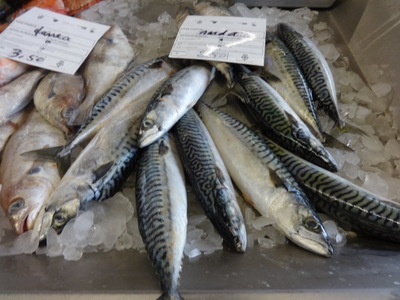
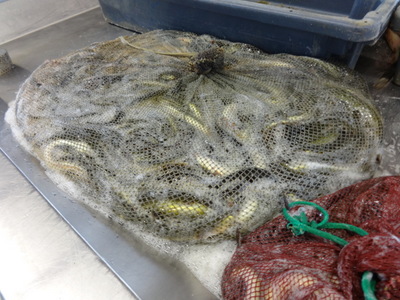 Next are what look to me like small mackerel. The Portuguese label seems to say "narda," but if it's actually "sarda" then they would be bonito.
Next are what look to me like small mackerel. The Portuguese label seems to say "narda," but if it's actually "sarda" then they would be bonito.
The somewhat shapeless mass in the right-hand photo is a mesh sack of small eels. You could tell they were fresh, because the sack was writhing slowly.
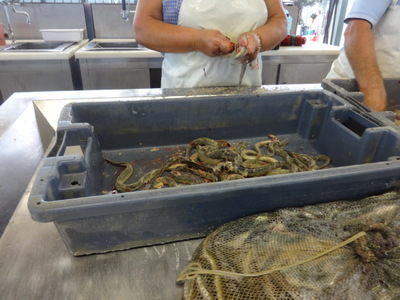
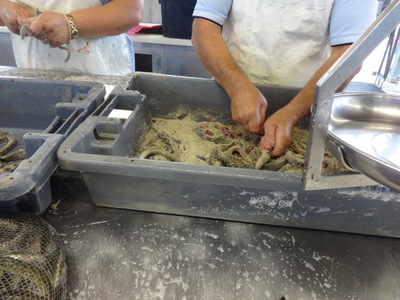 In a pair of plastic bins right behind the sack, two fishmongers were gutting little eels, which continued to writhe throughout the process. Notice that they are working in a pile of sand. Eels secrete slime and are so slippery that you can't really handle them "naked," as it were, so traditionally, in fish markets, they are kept in a bin of sand which makes it possible to pick them up when you want them. You just rinse the sand off before cooking.
In a pair of plastic bins right behind the sack, two fishmongers were gutting little eels, which continued to writhe throughout the process. Notice that they are working in a pile of sand. Eels secrete slime and are so slippery that you can't really handle them "naked," as it were, so traditionally, in fish markets, they are kept in a bin of sand which makes it possible to pick them up when you want them. You just rinse the sand off before cooking.
Note that the heads are left on. In some restaurants, the chef curls each little eel into a circle before frying by inserting the tail into the mouth. Others insert the tail into the slit belly and out through the mouth to make a graceful teardrop shape. Tasty either way.
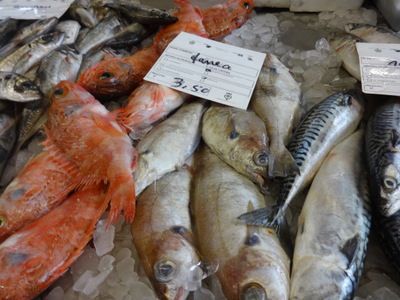
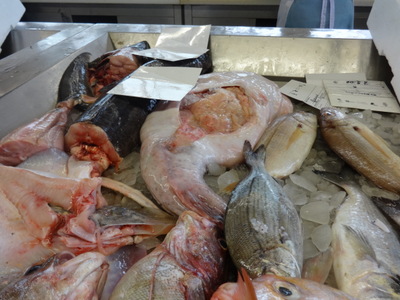 Next to the little bonito were these little guys labeled "fanea." If they really meant "faneca," then these are pout (they do look like photos I found of pout). To the left of the pout are bright red fish that might be ocean perch.
Next to the little bonito were these little guys labeled "fanea." If they really meant "faneca," then these are pout (they do look like photos I found of pout). To the left of the pout are bright red fish that might be ocean perch.
In the right-hand photo, pride of place is held by a good-sized monkfish, arranged on its back to display the size and quality of its tasty liver (we've had monkfish liver in France, labeled "foie gras of the sea").
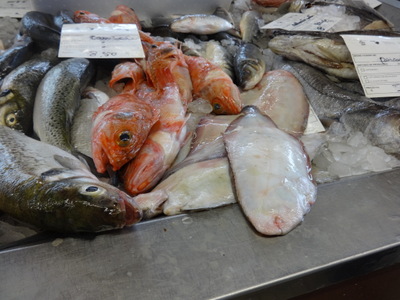
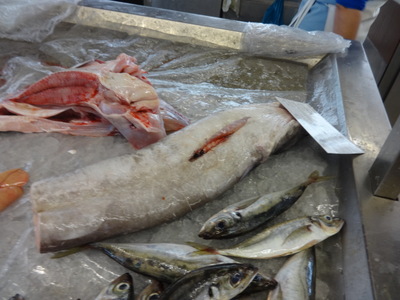 The pale ovals in the foreground here are sand dabs—small flatfish like flounder—displayed on their backs to show their shiny white bellies.
The pale ovals in the foreground here are sand dabs—small flatfish like flounder—displayed on their backs to show their shiny white bellies.
In the photo on the right is the front end of a fair-sized conger eel, also lying on its back for some reason. The tail end had already been sold off as slices or chunks.
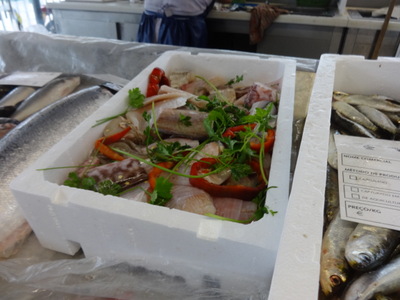
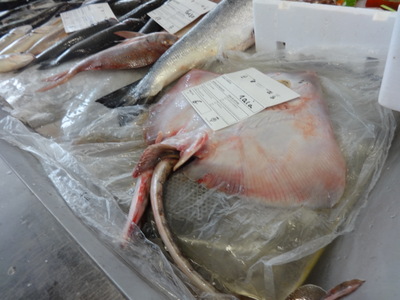 One vendor had assembled this multispecies assortment of slices and chunks and decorated it with parsley, sliced peppers, and chopped garlic, to suggest stew. Presumably, you can buy the mixture by the kilo.
One vendor had assembled this multispecies assortment of slices and chunks and decorated it with parsley, sliced peppers, and chopped garlic, to suggest stew. Presumably, you can buy the mixture by the kilo.
Finally, this handsome ray is displayed whole (and also on its back; no idea why almost everything flat enough to lie on its back was displayed that way), but most vendors displayed only the disembodied wings. I don't know whether the nonwing portions of a ray are good for anything, but I suppose you could make soup, as you could with any fish skeleton.
In addition to the items shown here, we saw daurade (gilthead seabream, large and small), both black and silver scabbard fish, salmon, large and small squid, whole octopus, gray mullet, sardines, "besugo" (blackspot seabream), and of course robalo (bar, Dicentrarchus labrax). Plus many, many others that weren't labeled and that I couldn't identify. Great market!
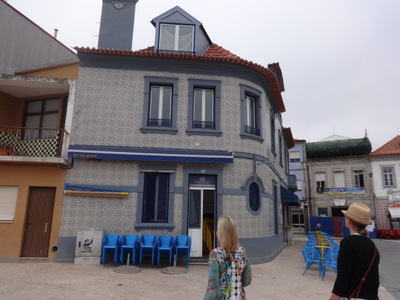
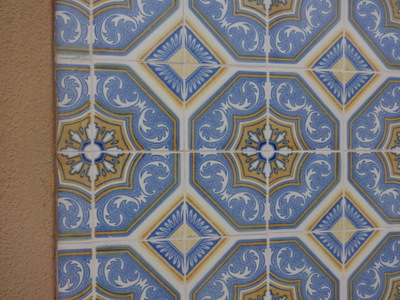 We planned to have lunch at the restaurant above the market, but it was still too early, so we spent some time strolling through the the old fishermen's neighborhood north of the market and east of the branch canal we had seen from our salt gondola.
We planned to have lunch at the restaurant above the market, but it was still too early, so we spent some time strolling through the the old fishermen's neighborhood north of the market and east of the branch canal we had seen from our salt gondola.
This tile-clad house, currently a guest house, was among the first we came to. The right-hand image is a close-up of its blue, white, and yellow tiles. We noted that its pattern repeated over four tiles. As was explained to us at the tile museum in Lisbon, a pattern that is the same on every tile is the least expensive, one that takes two tiles is more so, and one that repeats only over four tiles is even more. One that spans more than four tiles is probably custom made and unique.
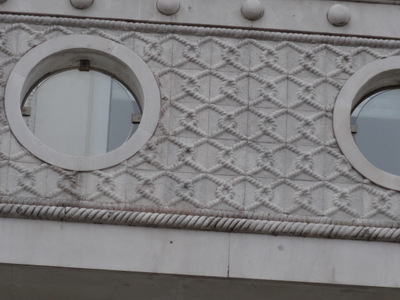
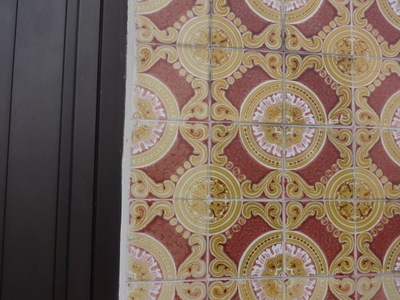 These tiles depicting a rope mesh adorned the balcony of a house that was almost entirely white but also featured many other nautical details, like anchors, pulleys, ships' wheels, and these round, porthole-like openings. Even the window frames were decorated with stylized fish heads.
These tiles depicting a rope mesh adorned the balcony of a house that was almost entirely white but also featured many other nautical details, like anchors, pulleys, ships' wheels, and these round, porthole-like openings. Even the window frames were decorated with stylized fish heads.
Blue and white are the traditional colors, but many houses branched out into other color schemes, like this four-tile red and yellow pattern.
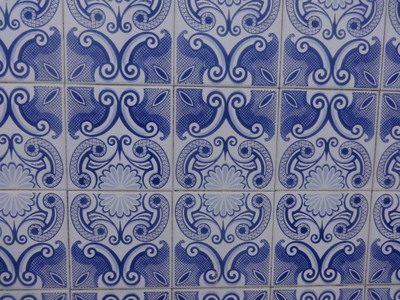
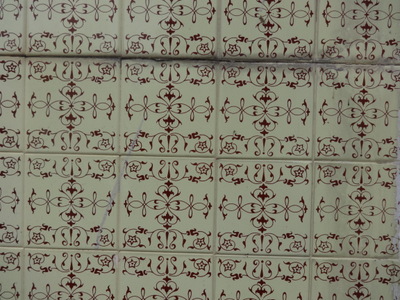 Here's an example of a two-tile pattern. In addition, these tiles look as though they were made in a modern factory rather than hand-painted.
Here's an example of a two-tile pattern. In addition, these tiles look as though they were made in a modern factory rather than hand-painted.
The one-tile pattern at the right features only "line drawing" rather than solid areas of color.

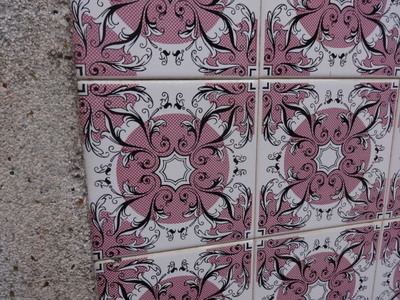 I gave up trying to determine the repeat of this dizzying modern pattern spanned more than one tile. Even if all the tiles are identical, they could have been rotated haphazardly, like the asphalt tiles on bathroom floors used to be. Feel free to study the image if you like; are all the tiles alike?
I gave up trying to determine the repeat of this dizzying modern pattern spanned more than one tile. Even if all the tiles are identical, they could have been rotated haphazardly, like the asphalt tiles on bathroom floors used to be. Feel free to study the image if you like; are all the tiles alike?
And speaking of old-fashioned asphalt tiles, the pattern in the right-hand photo says "1950's kitchen" to me, loud and clear.
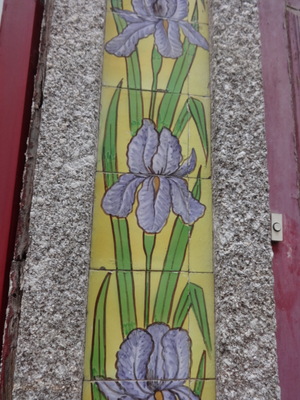
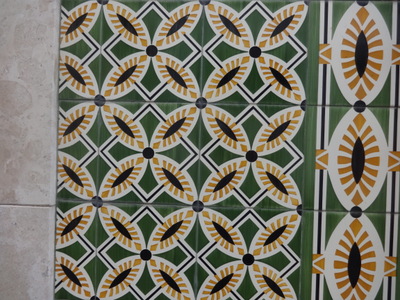 I love the irises on this strip of trim. It's basically a two-tile pattern, but if you'll look closely, you'll see that it doesn't repeat exactly. For exmaple, in the two lower blooms, compare the placement of the yellow flower center with respect to the tile boundary, as well as the treatment of the three upper petals in the two flowers. Clearly, this stip was custom made, painted across the whole strip of tiles.
I love the irises on this strip of trim. It's basically a two-tile pattern, but if you'll look closely, you'll see that it doesn't repeat exactly. For exmaple, in the two lower blooms, compare the placement of the yellow flower center with respect to the tile boundary, as well as the treatment of the three upper petals in the two flowers. Clearly, this stip was custom made, painted across the whole strip of tiles.
The photo at the right shows a contemporary take on a traditional style.
Once I counted up, I found that I had photographed 56 different tile patterns during our walk (don't panic; I'm not going to include all of them here). I took photos only of the ones I especially liked or found notable. We never found two houses that used the same pattern.
On this walk, we also got to cross and recross the fish-trap bridge. The circular walkway (tangent to the bank on each side) was wooden, like a boardwalk, but the railings were metal mesh. It's supported by eight steel cables, one for each of the eight provinces that chipped in to pay for it when it was built to commemorate a big soccer tournament. It was hard to photograph, but it did sort of resemble a fish trap.
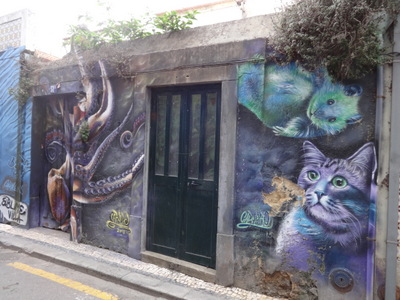
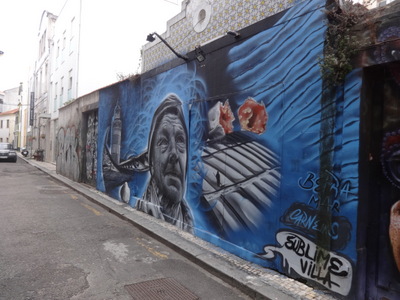 In addition to houses, we stopped to peak into several small neighborhood churches and a couple of shops.
In addition to houses, we stopped to peak into several small neighborhood churches and a couple of shops.
On the way back to the market, we walked past several beautiful murals. These two, which were right next to each other, were my favorites
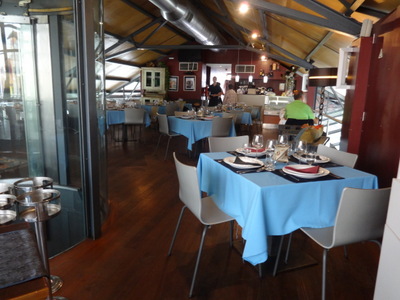
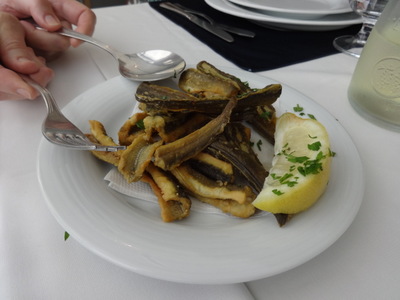 The fish-market restaurant is in a sort of loft high above the market floor, but it's all glassed in, so although you can look over the railing and see the fish displays below, you can't smell them or hear the noise.
The fish-market restaurant is in a sort of loft high above the market floor, but it's all glassed in, so although you can look over the railing and see the fish displays below, you can't smell them or hear the noise.
At the right is my appetizer portion of little fried eels. These have had their heads cut off. Once again, they were outstandingly delicious.
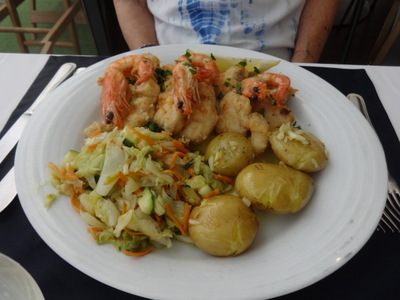
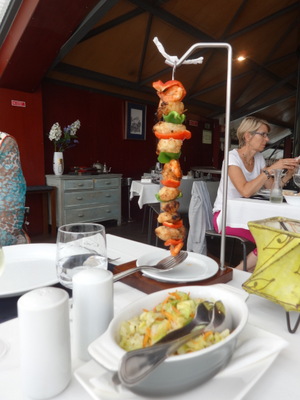 Jeannie ordered fried monkfish chunks topped with shrimp. Like all of our dishes, it came accompanied by slightly crushed new potatoes with a scattering of garlic and with the ubiquitous sauté of cabbage, carrot, onion, and other vegetables.
Jeannie ordered fried monkfish chunks topped with shrimp. Like all of our dishes, it came accompanied by slightly crushed new potatoes with a scattering of garlic and with the ubiquitous sauté of cabbage, carrot, onion, and other vegetables.
Kathy got the skewer of grilled monkfish and prawns, which were interspersed with chunks of red and green bell peppers.
It came suspended from this ingenious, space-saving device. Kathy could simply slide her plate underneath and slide down as many pieces as she wanted at a time.
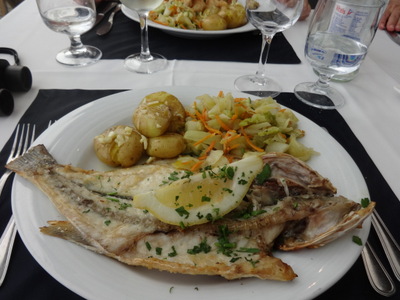
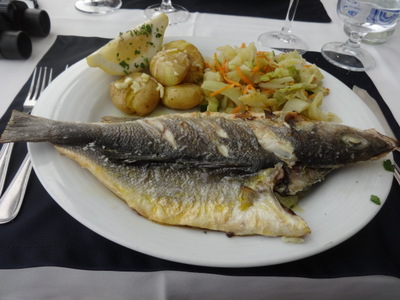 I jumped at the chance to order a whole grilled robalo, and it was outstanding! The fish was split, flattened, and slapped on the grill.
I jumped at the chance to order a whole grilled robalo, and it was outstanding! The fish was split, flattened, and slapped on the grill.
For some reason, split grilled fish are always served cut-side-up, maybe because so many people eat the flesh and leave the skin. Personally, I think the crispy skin is the best part, so I immediately flipped it skin-side-up before the skin could go soggy, draggling in the juice underneath. I can assure you, there wasn't much left when I was through with it; excellent!
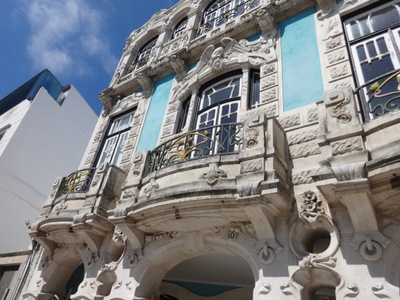
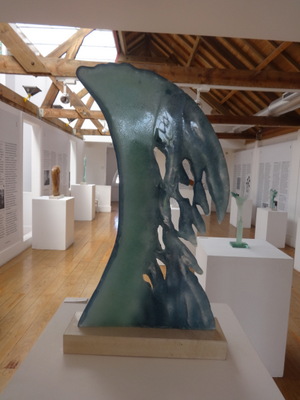 On our way out in the morning, we had stopped by the tourist office and reserved spaces in the afternoon's workshop on the making of ovos moles at the "Officine do Doce," back toward our hotel.
On our way out in the morning, we had stopped by the tourist office and reserved spaces in the afternoon's workshop on the making of ovos moles at the "Officine do Doce," back toward our hotel.
To make showing up on time easy, we planned our visit to the city's museum, which is right next door to the Officine, for the slot between lunch and our confectionary workshop.
The facade of the museum stands out among its more modern and much less ornate neighbors. This image shows just the upper two floors, above the elaborate wrought-iron sunflowers you've seen in other photos. Note the echo of the sunflowers in the balcony railings.
At the right is a piece, made of glass paste, that typifies the exhibit that occupied most of the space when we were there. It's the one portrayed on the exhibit's posters. I think it's called "The Tagus Nymph" (The Tagus is the longest river on the Iberian peninsula; it reaches the sea near Lisbon). Behind it, you can see many other pieces of the art, as well as long prose passages on the walls. The prose was a long alphabetical series of dictionary/encyclopedia entries. They had a theme, but I confess I don't remember what it was; I could read only parts, as they were, of course, in Portuguese.
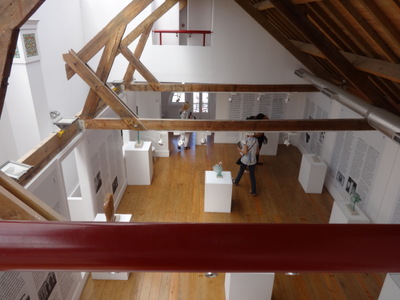
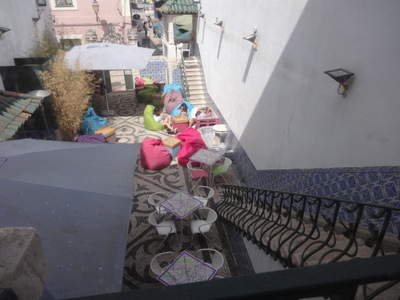 At one end of the stark exhibition space, which was at the top of the house, a stairway led up to a small loft. I found nothing up there but the chance to take this photo showing the gallery and its exposed beams.
At one end of the stark exhibition space, which was at the top of the house, a stairway led up to a small loft. I found nothing up there but the chance to take this photo showing the gallery and its exposed beams.
From a window at the back of the building, we could look down into this courtyard where several young women in shorts and sneakers were sitting in brightly colored beanbag chairs and sipping drinks. I assume the courtyard was associated with the museum, because the stylized street map on its tabletops matched the pattern on a glass coffee table we saw inside.
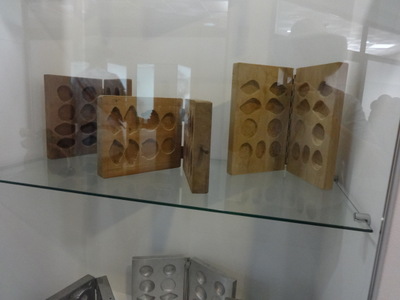
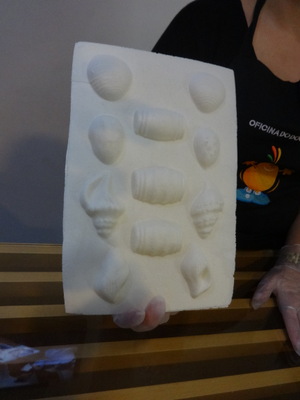 Then it was on to the "Cocina do Doce" (the sweets kitchen) for our ovos moles workshop. The process actually takes three days, so the hands-on part we got to see was only the middle step.
Then it was on to the "Cocina do Doce" (the sweets kitchen) for our ovos moles workshop. The process actually takes three days, so the hands-on part we got to see was only the middle step.
They are filled with "egg sweet," made on the first day: Mix 1 kg sugar and 1/2 kg water. Cook the mixture to 117°C, cool to below 100°C, incorporate 1 kg egg yolks (about 80), cook to 110°C.
The photo at the left here shows a variety of molds used to shape the confection. The one at the right shows a sheet of the wafer used to enclose the ovos moles, which is baked (while the egg sweet is cooking) in special mirror-image molds.
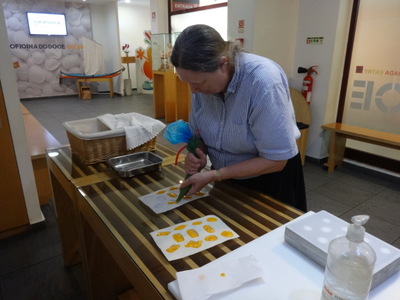
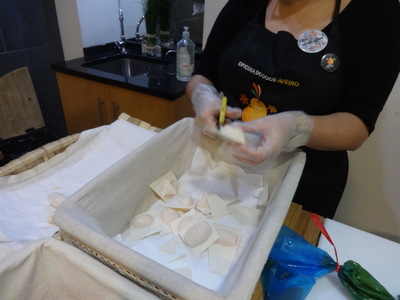 Here I am doing the second step. With a pastry bag, I am piping finished egg sweet into the depressions in two mirror image wafers. The filled wafers are then set into the two halves of a hinged mold that fits them (you can see it, closed, at the lower right), which is closed like a book. The moisture in the sweet causes the two halves to stick together.
Here I am doing the second step. With a pastry bag, I am piping finished egg sweet into the depressions in two mirror image wafers. The filled wafers are then set into the two halves of a hinged mold that fits them (you can see it, closed, at the lower right), which is closed like a book. The moisture in the sweet causes the two halves to stick together.
On the third day, the ovos moles, which have dried overnight, are cut apart with scissors. Our instructor cut up one from the previous day, and in the right-hand photo, she's trimming them close to the shapes. We got to taste the finished product on the spot.
We actually found them fairly insipid. Americans are so used to things like that being flavored with vanilla that pure egg and sugar seems very bland—sweet, but not much else.
This establishment uses 11 shapes: small barrels (like those used for shipping seaweed and salt), various shells, fishes, chestnut, dried fruit, etc. Not, surprisingly, eggs.
Egg sweet is also molded into life-sized chestnuts, which are dipped into additional egg yolk and then baked.
A third, very popular, form is egg yolks drizzled into boiling fat, fished out, and dried, forming little spaghetti-like strands called fios de ovos. Apparently, no Portuguese birthday cake is completely unless festooned with egg-yolk strands, which you buy by the pound.
The egg whites, now that hundreds of nuns don't need them for stiffening habits, are made into meringue cookies or into a spaciel soft sponge cake baked in little paper boats and eaten with a spoon.
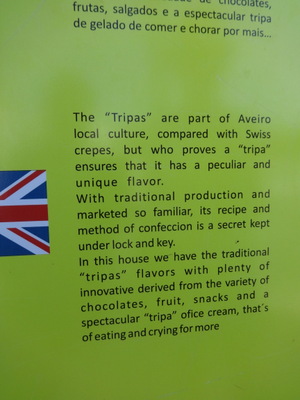
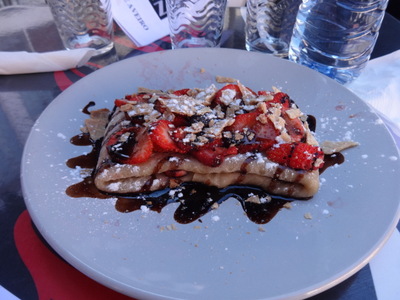 Next on our agenda was a tour of the cemetery, but we took our time getting there. Kathy wanted to check out a language school we had passed earlier, and we wanted to walk through the Forum, but one stop was at a little sidewalk establishment serving "tripas," translated "tripe."
Next on our agenda was a tour of the cemetery, but we took our time getting there. Kathy wanted to check out a language school we had passed earlier, and we wanted to walk through the Forum, but one stop was at a little sidewalk establishment serving "tripas," translated "tripe."
When I was preparing for this trip, I read about Aveiro and learned from some authoritative source that its inhabitants were so fond of tripe that they were nicknamed "tripe-eaters" by folks from elsewhere in Portugal. I was therefore surprised not to find tripe on any of the menus I read. Was it something eaten only at home? I was a little disappointed; I like tripe, and I hoped to try new preparations.
What this establishment served, however, was sort of a cross between an undercooked waffle and a thick crepe. Admittedly, it did look a lot like honeycomb tripe. And the one we tried, filled with strawberries, cream, and chocolate was good, but it also tasted and felt like a cross between an undercooked waffle and a thick crepe. Not an improvement on either the waffle or the crepe or even on actual tripe. I think that must be what Aveiro's population eats so much of and not the real article.
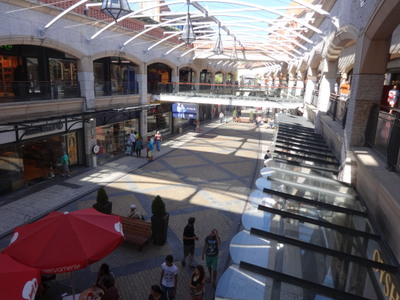
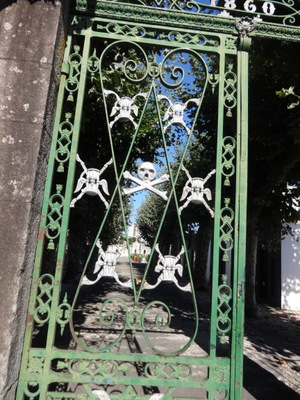 Eventually, we did reach the mall, which, as you can see, is a pretty big place. This is only one section.
Eventually, we did reach the mall, which, as you can see, is a pretty big place. This is only one section.
At the far end of it, though, we came to the cemetery. As you can see, the gates illustrate the theme of mortality. The white motifs surrounding the central skull and crossbones are winged hourglasses with scythes behind them—time flies, and then you are cut down. The date above the gates reads 1860.
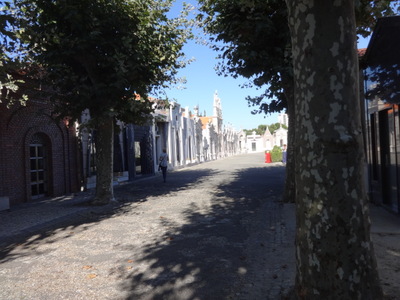
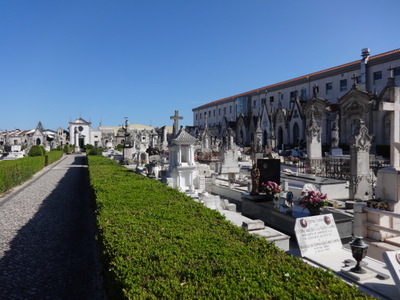 The vaults that line the left-hand side of this avenue, just inside the gates, are the ones whose back walls are visible above the cemetery wall (the ones the boat guide claimed were a tourist hotel). We walked back and forth past them daily as we followed the canal bank.
The vaults that line the left-hand side of this avenue, just inside the gates, are the ones whose back walls are visible above the cemetery wall (the ones the boat guide claimed were a tourist hotel). We walked back and forth past them daily as we followed the canal bank.
When you walk out to a point near the red trash container and turn to the right, you see this vista down the center of the cemetery toward the chapel at the far end. We walked down there, before turning left and continuing to our hotel, as it was almost time to meet the guys.
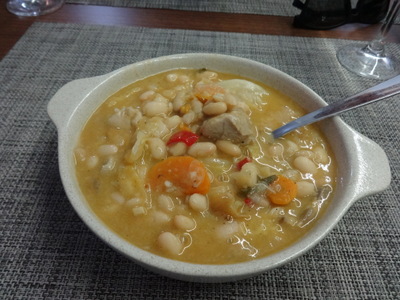
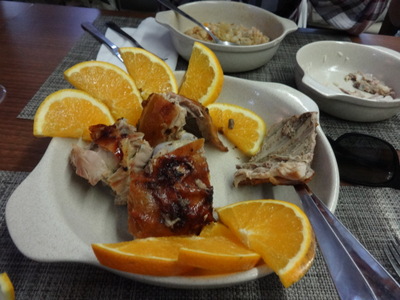 At dinner time, a group of us walked back down to the central square, and this time we managed to get a table at a little restaurant that had been full the night before. Its twin specialties were roast suckling pig and feijoada made with roast suckling pig. I was surprised to see how common roast-suckling-pig restaurants were in Portugal, and this was one of the better ones.\
At dinner time, a group of us walked back down to the central square, and this time we managed to get a table at a little restaurant that had been full the night before. Its twin specialties were roast suckling pig and feijoada made with roast suckling pig. I was surprised to see how common roast-suckling-pig restaurants were in Portugal, and this was one of the better ones.\
We ordered a plate of each and traded back and forth. Portuguese feijoada is made with white (or sometimes red) beans rather than the black ones used in Brazil, and this one was delicious—rich and full of beans, cabbage, and tender chunks of pork. The roast pork was also outstanding, succulent and crispy. The non-meat-eater in the group ordered a salad topped with tuna and surimi, and rice was served on the side.
Previous entry
List of Entries
Next entry

 The guys went off to the meetings are usual after breakfast, and Jeannie, Kathy, and I addressed ourselves to the next item on our list—the fish market! We passed through the regular vegetable and meat market on the way, but it had nowhere near the interest of the fish. The market itself is a purpose-built, modern square building with large doors on all four sides, built-in bins for fish and ice, floor drains and hoses, etc.
The guys went off to the meetings are usual after breakfast, and Jeannie, Kathy, and I addressed ourselves to the next item on our list—the fish market! We passed through the regular vegetable and meat market on the way, but it had nowhere near the interest of the fish. The market itself is a purpose-built, modern square building with large doors on all four sides, built-in bins for fish and ice, floor drains and hoses, etc.
 Next are what look to me like small mackerel. The Portuguese label seems to say "narda," but if it's actually "sarda" then they would be bonito.
Next are what look to me like small mackerel. The Portuguese label seems to say "narda," but if it's actually "sarda" then they would be bonito.
 In a pair of plastic bins right behind the sack, two fishmongers were gutting little eels, which continued to writhe throughout the process. Notice that they are working in a pile of sand. Eels secrete slime and are so slippery that you can't really handle them "naked," as it were, so traditionally, in fish markets, they are kept in a bin of sand which makes it possible to pick them up when you want them. You just rinse the sand off before cooking.
In a pair of plastic bins right behind the sack, two fishmongers were gutting little eels, which continued to writhe throughout the process. Notice that they are working in a pile of sand. Eels secrete slime and are so slippery that you can't really handle them "naked," as it were, so traditionally, in fish markets, they are kept in a bin of sand which makes it possible to pick them up when you want them. You just rinse the sand off before cooking.
 Next to the little bonito were these little guys labeled "fanea." If they really meant "faneca," then these are pout (they do look like photos I found of pout). To the left of the pout are bright red fish that might be ocean perch.
Next to the little bonito were these little guys labeled "fanea." If they really meant "faneca," then these are pout (they do look like photos I found of pout). To the left of the pout are bright red fish that might be ocean perch.
 The pale ovals in the foreground here are sand dabs—small flatfish like flounder—displayed on their backs to show their shiny white bellies.
The pale ovals in the foreground here are sand dabs—small flatfish like flounder—displayed on their backs to show their shiny white bellies.
 One vendor had assembled this multispecies assortment of slices and chunks and decorated it with parsley, sliced peppers, and chopped garlic, to suggest stew. Presumably, you can buy the mixture by the kilo.
One vendor had assembled this multispecies assortment of slices and chunks and decorated it with parsley, sliced peppers, and chopped garlic, to suggest stew. Presumably, you can buy the mixture by the kilo.
 We planned to have lunch at the restaurant above the market, but it was still too early, so we spent some time strolling through the the old fishermen's neighborhood north of the market and east of the branch canal we had seen from our salt gondola.
We planned to have lunch at the restaurant above the market, but it was still too early, so we spent some time strolling through the the old fishermen's neighborhood north of the market and east of the branch canal we had seen from our salt gondola.
 These tiles depicting a rope mesh adorned the balcony of a house that was almost entirely white but also featured many other nautical details, like anchors, pulleys, ships' wheels, and these round, porthole-like openings. Even the window frames were decorated with stylized fish heads.
These tiles depicting a rope mesh adorned the balcony of a house that was almost entirely white but also featured many other nautical details, like anchors, pulleys, ships' wheels, and these round, porthole-like openings. Even the window frames were decorated with stylized fish heads.
 Here's an example of a two-tile pattern. In addition, these tiles look as though they were made in a modern factory rather than hand-painted.
Here's an example of a two-tile pattern. In addition, these tiles look as though they were made in a modern factory rather than hand-painted. I gave up trying to determine the repeat of this dizzying modern pattern spanned more than one tile. Even if all the tiles are identical, they could have been rotated haphazardly, like the asphalt tiles on bathroom floors used to be. Feel free to study the image if you like; are all the tiles alike?
I gave up trying to determine the repeat of this dizzying modern pattern spanned more than one tile. Even if all the tiles are identical, they could have been rotated haphazardly, like the asphalt tiles on bathroom floors used to be. Feel free to study the image if you like; are all the tiles alike?
 I love the irises on this strip of trim. It's basically a two-tile pattern, but if you'll look closely, you'll see that it doesn't repeat exactly. For exmaple, in the two lower blooms, compare the placement of the yellow flower center with respect to the tile boundary, as well as the treatment of the three upper petals in the two flowers. Clearly, this stip was custom made, painted across the whole strip of tiles.
I love the irises on this strip of trim. It's basically a two-tile pattern, but if you'll look closely, you'll see that it doesn't repeat exactly. For exmaple, in the two lower blooms, compare the placement of the yellow flower center with respect to the tile boundary, as well as the treatment of the three upper petals in the two flowers. Clearly, this stip was custom made, painted across the whole strip of tiles.
 In addition to houses, we stopped to peak into several small neighborhood churches and a couple of shops.
In addition to houses, we stopped to peak into several small neighborhood churches and a couple of shops.
 The fish-market restaurant is in a sort of loft high above the market floor, but it's all glassed in, so although you can look over the railing and see the fish displays below, you can't smell them or hear the noise.
The fish-market restaurant is in a sort of loft high above the market floor, but it's all glassed in, so although you can look over the railing and see the fish displays below, you can't smell them or hear the noise.
 Jeannie ordered fried monkfish chunks topped with shrimp. Like all of our dishes, it came accompanied by slightly crushed new potatoes with a scattering of garlic and with the ubiquitous sauté of cabbage, carrot, onion, and other vegetables.
Jeannie ordered fried monkfish chunks topped with shrimp. Like all of our dishes, it came accompanied by slightly crushed new potatoes with a scattering of garlic and with the ubiquitous sauté of cabbage, carrot, onion, and other vegetables.
 I jumped at the chance to order a whole grilled robalo, and it was outstanding! The fish was split, flattened, and slapped on the grill.
I jumped at the chance to order a whole grilled robalo, and it was outstanding! The fish was split, flattened, and slapped on the grill.
 On our way out in the morning, we had stopped by the tourist office and reserved spaces in the afternoon's workshop on the making of ovos moles at the "Officine do Doce," back toward our hotel.
On our way out in the morning, we had stopped by the tourist office and reserved spaces in the afternoon's workshop on the making of ovos moles at the "Officine do Doce," back toward our hotel.
 At one end of the stark exhibition space, which was at the top of the house, a stairway led up to a small loft. I found nothing up there but the chance to take this photo showing the gallery and its exposed beams.
At one end of the stark exhibition space, which was at the top of the house, a stairway led up to a small loft. I found nothing up there but the chance to take this photo showing the gallery and its exposed beams.
 Then it was on to the "Cocina do Doce" (the sweets kitchen) for our ovos moles workshop. The process actually takes three days, so the hands-on part we got to see was only the middle step.
Then it was on to the "Cocina do Doce" (the sweets kitchen) for our ovos moles workshop. The process actually takes three days, so the hands-on part we got to see was only the middle step.
 Here I am doing the second step. With a pastry bag, I am piping finished egg sweet into the depressions in two mirror image wafers. The filled wafers are then set into the two halves of a hinged mold that fits them (you can see it, closed, at the lower right), which is closed like a book. The moisture in the sweet causes the two halves to stick together.
Here I am doing the second step. With a pastry bag, I am piping finished egg sweet into the depressions in two mirror image wafers. The filled wafers are then set into the two halves of a hinged mold that fits them (you can see it, closed, at the lower right), which is closed like a book. The moisture in the sweet causes the two halves to stick together.
 Next on our agenda was a tour of the cemetery, but we took our time getting there. Kathy wanted to check out a language school we had passed earlier, and we wanted to walk through the Forum, but one stop was at a little sidewalk establishment serving "tripas," translated "tripe."
Next on our agenda was a tour of the cemetery, but we took our time getting there. Kathy wanted to check out a language school we had passed earlier, and we wanted to walk through the Forum, but one stop was at a little sidewalk establishment serving "tripas," translated "tripe."
 Eventually, we did reach the mall, which, as you can see, is a pretty big place. This is only one section.
Eventually, we did reach the mall, which, as you can see, is a pretty big place. This is only one section.
 The vaults that line the left-hand side of this avenue, just inside the gates, are the ones whose back walls are visible above the cemetery wall (the ones the boat guide claimed were a tourist hotel). We walked back and forth past them daily as we followed the canal bank.
The vaults that line the left-hand side of this avenue, just inside the gates, are the ones whose back walls are visible above the cemetery wall (the ones the boat guide claimed were a tourist hotel). We walked back and forth past them daily as we followed the canal bank.
 At dinner time, a group of us walked back down to the central square, and this time we managed to get a table at a little restaurant that had been full the night before. Its twin specialties were roast suckling pig and feijoada made with roast suckling pig. I was surprised to see how common roast-suckling-pig restaurants were in Portugal, and this was one of the better ones.\
At dinner time, a group of us walked back down to the central square, and this time we managed to get a table at a little restaurant that had been full the night before. Its twin specialties were roast suckling pig and feijoada made with roast suckling pig. I was surprised to see how common roast-suckling-pig restaurants were in Portugal, and this was one of the better ones.\